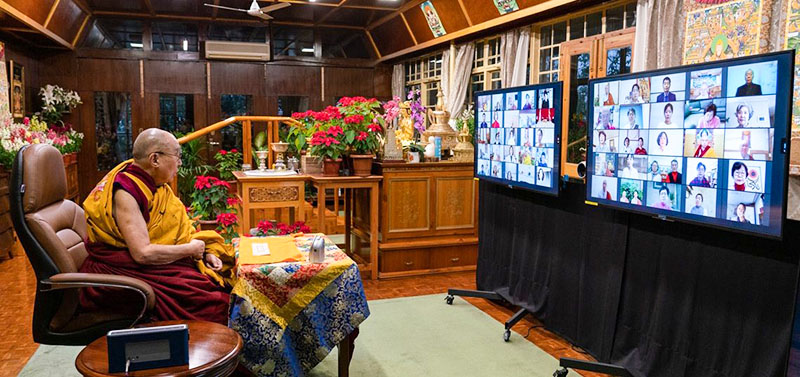Dharamshala, India — “The true nature of the mind is clarity and awareness. Mental defilements are temporary and adventitious; therefore, they can be eliminated from the mind,” explained His Holiness the 14th Dalai Lama during the three-day teaching on Heart Sutra from January 5 to end on January 7, 2021.
The three-day online teachings are at the request of Buddhists from South Korea. The Tibetan spiritual leader began the online teaching from his residence in Dharamshala, HP for Korean devotees in South Korea on Heart Sutra. He was welcomed by Korean Abbot Ven JinOk on the first day and informed the Korean disciples’ request that he explain the Heart Sutra to them. Ven JinOk proceeded to recite the Sutra.
His Holiness the Dalai Lama begins his teaching by saying: “Today, we are beginning three days of teachings for a group of Dharma brothers and sisters from Korea.” His Holiness announced. “I feel very fortunate to have this opportunity. There are Perfection of Wisdom sutras in 100,000 lines, 25,000 lines and 8,000 lines, while the shortest version consists of the letter ‘A’. The ‘Heart Sutra’ is referred to as the ‘Perfection of Wisdom in 25 Lines’, and despite its relative brevity, it is a comprehensive text.
“The Perfection of Wisdom teachings cannot be followed merely on the basis of faith. These are the kind of teachings that those of sharp intelligence follow on the basis of reason. The word wisdom in the name of these teachings shows that to understand them requires intelligence and the exercise of our analytical faculty. As the Buddha advised his followers, 'O monks and scholars, as gold is tested by burning, cutting and rubbing, examine my words thoroughly and accept them only then — not just out of respect for me,' mentioned the Nobel Laureate.
On the second day, His Holiness the Dalai Lama continued to explain the text. “In the first round of Buddha Shakyamuni’s teachings he made clear that suffering must be known, ignorance must be eliminated and true cessation must be actualized by cultivating the path. The true nature of the mind is clarity and awareness. Mental defilements are temporary and adventitious; therefore, they can be eliminated from the mind. The Nalanda masters taught that the potential to attain enlightenment is naturally within us. The basic nature of the mind can be recognised. As we eliminate defilements, the qualities of a Buddha, such as the ten powers and so forth, naturally emerge,” he clarified.
“In our monastic centres of learning we study the works Nagarjuna and Chandrakirti composed on the basis of reason and logic. Chandrakirti says that the profound view of emptiness can be realized by those with a propensity from the past. Mind-Only and the Middle Way are the two principal Buddhist schools of philosophy. Mind Only states that there is no duality between subject and object. The Middle Way School asserts that things do not exist independently. The Middle Way Consequentialists represented by Chandrakirti declare that if it is asserted that things have some objective or self-characterized nature then four logical absurdities ensue,” is Holiness further added.
“If things had some sort of existence from their own side, the way ignorance misconceives it, it should be findable. The different forms, sounds and smells around us appear to exist from their own side, but cannot be found to actually exist that way. Even the form body and truth body of a Buddha cannot be found when their intrinsic identity is sought,” the Dalai Lama observed. “‘Form is empty’, so it can’t be found under analysis. But does this mean it doesn’t exist? It does not, because form exists in dependence on other factors. As I yesterday quoted Nagarjuna as saying, ‘That which is dependently arisen is explained to be emptiness. That, which is a dependent designation, is itself the middle way’. Since form and so forth exist and affects us, we say that they exist, but not by their own nature,” he conveyed.
On the final day after the greetings, His Holiness the Dalai Lama asked his devotees to reflect on what had been discussed earlier and read the scriptures. Emphasising on teaching alone will not help in its comprehension without reading, he reminded. Reading allows one to gain more insight in transformation of the mind. He continued the teaching on emptiness and how things do not exist how they appear to be. Therefore, there is disparity like illusion. He also touched upon the four Noble truths of Buddha. The three-teaching concluded on a success note with an A & Q session. A note of thanks and long life wishes by Korean Abbot Ven JinOk to His Holiness the Dalai Lama.


![Tibet has a rich history as a sovereign nation until the 1950s when it was invaded by China. [Photo: File]](/images/stories/Pics-2024/March/Tibet-Nation-1940s.jpg#joomlaImage://local-images/stories/Pics-2024/March/Tibet-Nation-1940s.jpg?width=1489&height=878)
















